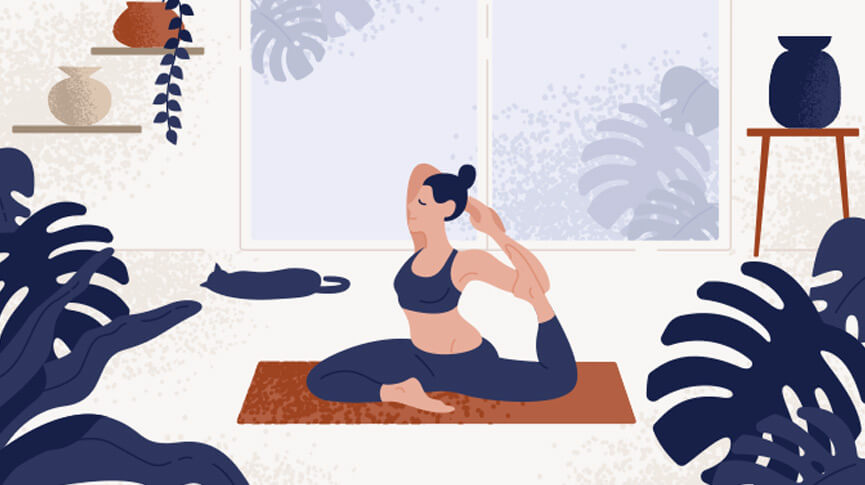Working Out with Your Menstrual Cycle

Do you tend to put a lot of pressure on yourself to meet your workout goals? Or stay active no matter how you’re feeling or where you’re at in your cycle? Do any of these quotes sound familiar to you?
‘I was hitting my workout goals all month, then BAM I took a whole week off.’, ‘I thought I had to work out at least three times a week every week to be in shape.’, ‘I know I should, but I’m just too tired to work out before and during my period.’
For people who bleed, your menstrual cycle can have a huge impact on your energy levels throughout the month, and thus your ability (or desire) to keep up with a regimented workout routine. We’re here to normalize taking breaks, resting, pushing yourself when it feels right, and finding a workout routine that works with your menstrual cycle.
The Menstrual Cycle
Understanding the different phases of the menstrual cycle can help you find a workout routine that works for you, or help alleviate any guilt you might feel for not working out when you think you should. The average menstrual cycle length is 28 days. However, anywhere from 21 to 40 days is still within the realm of normal. Here’s a breakdown of the menstrual cycle phases and what sort of workouts might work during these times:
Your menstrual cycle starts with the first day of your period and ends when your next period begins. It can be broken down into two main phases: follicular and luteal. The follicular phase starts the first day of your period and ends with ovulation, which is the beginning of the luteal phase. Within these phases, there are different stages.
Day 1-7: Menstruation and bleeding when levels of estrogen and progesterone are low. This is the time to get all the rest. If you want to get some movement in, opt for a walk, stretching, or yoga for period cramps. You might start to get more energy towards the end of your period, where it might feel right to amp up your workouts.
Day 7-14: This is the later part of your follicular phase. Estrogen levels start to rise as your body gets ready to release an egg. This is the best time in your cycle to do more intense training if you’re an athlete, or more strength and endurance workouts.
Day 14-21: Estrogen levels drop again immediately following ovulation. Some people might have a surge of energy, while others will feel tired. You might want to tone down your movement routine, but will still probably feel great being somewhat active with. Some research suggests that menstruating people fatigue faster from intense workouts in the later part of their cycle. So don’t push yourself if you feel like you’re just getting burnt out easily. Try workouts that maintain a steady, consistent pace like bike riding and pilates.
Day 21-28: If you start to feel less energetic in the week or so before your period, try toning down your workouts to a pace where you can keep some momentum, but also leave you space for rest. You still might feel fine doing light strength training and Yoga or switching to more restorative Yoga and gentle stretches.
What Impacts Your Menstrual Cycle
Besides your normal run-of-the-mill period tiredness, there’s a whole bunch of other factors that can make you feel extra tired during certain parts of your cycle, and impact your workout routine.
If you feel like it’s extremely difficult to get moving around the time of your period, it could be in part due to:
- Thyroid or endocrine system (hormonal) issues
- Endometriosis or PCOS
- Stress or mental health issues like anxiety and depression
- Food sensitivities
If you feel intense pain, extreme energy dips, or anything else around your cycle that affects your movement routine and your overall well-being – seek out support from a medical professional.
There Are So Many Kinds of Movement
There’s a common belief in Western societies that in order to reach your “fitness goals” or be “in shape” you have to work out hard, and often. While this might be true for some people, it doesn’t have to be the case for everyone. There are so many other ways to move your body that feel more easeful, and more sustainable no matter where you’re at in your cycle. Some other ways to move your body besides pumping iron are:
- Walking: Don’t underestimate it!
- Dancing: You can just wiggle around your room to your favorite song
- Gentle Yoga and stretching
- Pilates
- Fun sports with friends like frisbee, volleyball, or just kicking a ball around
- Sex: Our favorite way to get moving
If it feels good and helps you feel comfortable in your body, and supports your mental health and cognition, that’s what matters at the end of the day.
Working Out With Your Cycle: What to Remember
Everybody and every body is different. You might find that you have more or less during certain times of your cycle than what’s discussed in this article. For some people, pushing themselves to do more than they think they can helps to relieve some symptoms of PMS. You know your body best. We hope that this information gives you some guidelines, insight, or support on finding a routine that works for your needs and menstrual cycle. Trust your body, listen to your intuition, and know that it’s ok to rest, it’s ok to take it easy, and it’s definitely ok to rest.

Natasha (she/her) is a full-spectrum doula and health+wellness copywriter. Her work focuses on deconstructing the shame, stigma, and barriers people carry around birth, sex, health, and beyond, to help people navigate through their lives with more education and empowerment. You can connect with Natasha on IG @natasha.s.weiss.



FINALLY a place where I can have it all in one! I’ve been looking for this type of table and advice for some time now, so I got pretty much tired of calculating where I’m at with my body. Thanks for this!